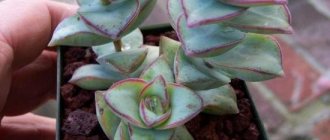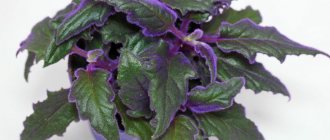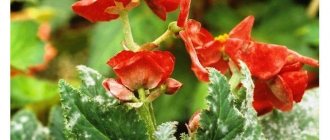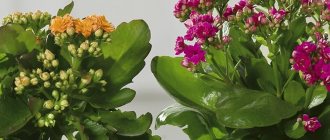How to properly propagate begonia from leaves, what do you need to know for this and what tricks to follow so that a new plant grows from a leaf? We take photographs and explain every step.
First of all, you need to purchase a healthy-looking plant from a flower shop: it should not look weak and lethargic. To propagate begonias, select whole leaves that are free of damage. We will try to propagate begonia in three ways: a leaf in water, a leaf in the ground, and a fragment of a leaf plate in the ground.
Begonia species with dense leaves are suitable for propagation by leaf method.
Description of the flower
There are four groups of begonias:
- decorative deciduous - without an aboveground stem, with long leaves and ornate roots;
- bush - with branched, dense stems and many side shoots;
- flowering - distinguished by shiny, bright leaves and a long flowering period. They are considered the easiest to grow and care for;
- tuberous - have tall (up to 70-80 cm) translucent stems and tuberous rhizomes. Planting and caring for tuberous begonia from seeds is also quite simple.
Begonia propagation
Care activities
In order for tiger begonia to grow and develop normally at home, you must follow some rules for its cultivation. Remember that the place where the flower will stand should be well illuminated with diffused light.
A great place to grow begonias is a slightly cool balcony, because there they can get enough light. Moreover, in such a place the plant will be completely protected from the wind.
Also, do not forget that it is best to place the plant on the north side, because if the light is too bright, the leaf blades of the begonia will quickly lose their beautiful color and become dull. If you placed the flower on the south side, then in this case it is better to create a shadow for it.
The soil and air must always be moist. To water the plant, use only soft water at room temperature.
In the warm season, the flower can be moistened as the soil dries. Don't forget that too much water can cause the root system to rot. In winter, watering and fertilizing can be reduced to a minimum.
Tiger begonia is a heat-loving plant. It can be grown at temperatures not lower than 18–19 degrees. This flower needs feeding in the warm season (it is better to purchase it in a specialized store). But the concentration for this variety should be less, since it does not like too saturated compositions. They can be applied no more than once a month.
Even though begonia loves high levels of humidity, it should not be sprayed. Otherwise, spots may appear on its leaf blades. Most often, a container with damp moss is placed under the plant. If you don’t have it, you can use raw expanded clay or just water.
Once every two or three years, the flower should be rejuvenated. To do this, first select a new wide pot, at the bottom of which drainage and pre-prepared soil are placed. Then the flower is carefully removed from the old container and trimmed, leaving only the upper part of the rhizome and leaves.
After this, the root system is placed in a new pot with soil. Then the plant is well watered with clean water at medium temperature. A transparent bag with small holes made in it for ventilation is put on the container. This is necessary so that the moisture does not evaporate too quickly.
After this, it is recommended to periodically ventilate. The transparent bag can be completely removed only when new young leaves appear on the plant.
Peculiarities
At home, begonia propagates by cuttings, seeds, and tubers. But it is leaf propagation that is used most often. This is due to a large number of positive characteristics.
- Losing one leaf will not in any way affect the health or appearance of the plant.
- None of the stages requires special skills, effort or time.
- This method can be considered the most productive: after all, about 10 shoots can be obtained from one leaf plate.
- For some varieties of begonias, this reproduction option is practically the only one.
- Unlike propagation by seeds, you will know exactly what the future plant will look like.
- Planting material acts as a source of nutrition. Thanks to the beneficial substances it contains, shoots will grow faster than from seeds.
In addition, the sheet itself can be used in different ways:
- wait for the roots to appear by placing it in water;
- land in the ground.
In the latter option, you can use the whole plate or divide it into parts.
Preparation of planting material
How to properly plant a begonia cutting? Initially, it is necessary to select good planting material. Cuttings can be taken from the top of the bush or from side shoots. Usually it is possible to collect a lot of planting material when pruning a bush. Begonias are considered very tenacious, so for rooting they actually need only one growth point (leaf or bud on a branch). But it’s better if there are 3-4 of them. Therefore, cuttings are made 15-20 cm long, with an oblique cut at the bottom. The bottom leaf is cut off completely, a third is cut off from the top ones so that the leaf plates do not absorb a lot of vital juices.
For leaf cuttings, select leaves that are strong, without signs of disease, yellowing, or wilting, with developed veins.
There are two main ways to root begonia from cuttings - in water or soil. They are considered to be equivalent. But when planting in water, cuttings need to be prepared with a reserve, since some will certainly be lost. In addition, there is an opinion that when planted directly into the ground, healthier and stronger plants are obtained.
When can begonia be propagated by leaf?
As a rule, this process does not have any time restrictions, however, it is generally accepted that plants rest in winter - for this reason, gardeners have an unspoken rule to replant and propagate plants from March to October inclusive, and not to disturb them the rest of the time.
Propagation by leaf cuttings
Fragments of a leaf
- Prepare everything you need: a sharp knife, a begonia leaf, a board or glass, substrate, drainage, pots, a plastic bag, activated carbon, “Kornevin”.
- Remove the leaf petiole.
- Cut the leaf placed on a board radially with a sharp knife from the middle to the edge into fragments in the form of triangles, each of which should have one or two veins, since all nutrients move along it. One sheet can produce 10 or more fragments.
- Treat the sections with crushed activated carbon mixed with Kornevin.
- Place a layer of drainage into the bottom of the container, then pour moistened substrate onto 2/3 of the pot.
- Having made a small groove in the ground, deepen the fragment into it with a cut downwards by 5 - 7 mm.
- Lightly crush the substrate with your hands, thus fixing the leaf segment.
- Cover the container with a plastic bag on top or place the pot in a special transparent plastic container that acts as a greenhouse.
Schefflera propagation: interesting methods and examples of planting
Some plant species do not have a stem, so the question arises of how to propagate begonia from leaves. You need to cut a healthy leaf from the plant and place it on a hard surface. It is worth taking a sharp blade or knife and cutting the leaf from the midrib to the edges of the triangles so that at least one vein passes through each of them.
Since it is quite difficult to root such a begonia, you can simply lay sections of the leaf on wet sand or try to stick the leaves with the cut of the vein into the soil.
Important! Caring for leaf cuttings is no different from others. It is necessary to cover the tank with the plant with a plastic bag, lid, jar or bottle so that the plant does not touch the walls. It is worth ventilating and humidifying the air in the container every day. You can stop keeping begonia in the greenhouse when new leaves appear.
Begonia propagation by leaf
leaf
First you need to prepare a large begonia leaf . It must look absolutely healthy, without damage or infection. Then you can leave it whole, or cut it into fragments. Each piece should have a portion of the midrib.
Advice! It is necessary to cut with a very sharp object. If you do not plan to separate the leaf blade, you can put the leaf in water until the roots appear. Place it in the place where the petiole was. Pre-dissolve an activated carbon tablet in water.
Cut on a sheet
Begonia can be propagated by making cuts on the leaf . To do this you need:
- Take a large begonia leaf, a knife, a pot, substrate, drainage, pebbles (pebbles), and plastic film.
- The bottom of the pot is filled with drainage, then with a moistened substrate.
- A large and healthy leaf (length 7 cm or more) is cut with a sharp knife across the veins in several places (the distance between cuts should be 2 - 3 cm).
- The cut leaf is placed face down on moist soil in a pot.
- Using small pebbles, the sheet is pressed to the substrate in places near the cuts.
- Cover the top with plastic wrap.
Rooting in water
The cuttings are immersed in a vessel with water at room temperature. You should not use hard or cold ones for these purposes. Place the vessel with the plant in a bright but not sunny place with a temperature of at least 18 °C.
A transparent container will allow you to observe the cut; after the first roots appear, the sprouts can be planted. You can also notice in time if the cut begins to rot. In this case, you need to remove the shoot from the water, cut off the damaged area, dry it and put it back into the water, preparing fresh water.
The cutting is ready for planting if the size of the roots reaches 2 cm.
Rooting in the substrate
The substrate can be wet peat, sand, or soil for begonias. The prepared cutting must be dipped into water, then into a product that will facilitate the formation of roots. It is recommended to prepare a small pot in advance, pour pebbles on top of the substrate as drainage, and deepen the cutting 2 cm deep.
After the work has been done, you need to tightly close the pot using a jar, glass or lid. In this case, no part of the plant should touch the walls or lid of the tank in which it is located.
Rooting begonia in the substrate
After some time, the inside of the container will be covered with perspiration, which indicates the formation of a microclimate suitable for reproduction. Every day it is worth opening the greenhouse slightly for a few minutes to ventilate the plant. Gradually it is worth increasing the time the flower spends in the fresh air. When new leaves appear, it is worth removing the lid completely, since the plant has become entrenched in the soil.
The soil
To root the leaf, a porous, moisture-absorbing soil with a neutral reaction and low humus content is required. To obtain soil with such characteristics, it is enough to mix peat and sand equally. Why use this mixture, and not ordinary soil:
- Sand prevents moisture from remaining on the soil surface and promotes its even distribution.
- Peat is more of a structural element instead of fertile soil, which itself contributes to the rotting of leaves falling on it.
- This soil breathes well, so rooting occurs well in it.
The soil for rooting should be at room temperature and moist . You don't need a large amount, 80-100 ml is enough. Before planting, it is necessary to disinfect the soil mixture with a saturated solution of potassium permanganate, or fry it in the oven. You can freeze the soil for a couple of days. More information about the soil for begonias and the correct planting conditions can be found here.
How to propagate begonia with leaf fragments, watch the video
Landing
Planting a leaf for the purpose of propagation can be done using different methods:
- Planting a leaf rooted in water . After the roots appear, the leaf is planted in a pot with a substrate.
- Rooting a whole leaf in the soil. The leaf is laid out on the ground with its face up and pressed against the soil with a weight in the form of pebbles.
- Rooting leaf fragments . Each segment is immersed in the soil at the cut point.
Choosing the “right” pot
To root begonia leaf fragments, you do not need any special containers. Most often, experienced gardeners use 100-gram plastic cups with drainage holes made in the bottom. You can also use plastic containers. It is better if the walls of the container are transparent: this makes it easier to observe the emergence and development of the root system of a young plant.
Soil selection
Important : The main requirement for soil for begonias is that it must be loose and breathable, with a low humus content.
- Option 1 : To root leaf fragments, you can use peat and coconut tablets: after soaking the tablets in warm, settled water, mix them in a 1:1 ratio, add 10% - 20% of perlite from the main volume of the substrate.
- Option 2 : 1 part peat is mixed with 1 part river sand.
- Option 3 : Mix sand with crushed sphagnum 1:1.
Choosing a vessel for rooting
The plant has small roots, so you should choose a low, small pot for it. In this case, the substrate will quickly get rid of excess moisture, so it is less likely to die. In this case, during rooting, the plant will not remain in the container for long; when roots appear, you will need to choose an individual pot.
Note! Lighting for cuttings is necessary to the same extent as for adult plants, so the rooting period should be carried out in a well-lit place. You can use a regular plastic cup as a vessel.
The pot that will be used after transplantation should not be more than 800 ml in volume, and it is worth making a hole in the bottom so that excess water can drain through it. If the plant becomes cramped in the pot, you will have to choose a larger option. After replanting, it is recommended to keep the plant for a couple of days in a darker place than usual.
Air layering
The air layering method is recommended for plants with long shoots. To get a daughter begonia, you should choose a branch whose length exceeds 20 cm. About 10 cm on this stem should be cleared of leaves, and a ring cut of up to 2 mm should be made on it. The cut itself must be treated with a root formation activator and wrapped in moistened sphagnum moss. This place needs to be wrapped in dark polyethylene, securing its edges.
Air layering method
Note! You need to completely wrap the moss in plastic to prevent it from drying out. Otherwise, root formation will not occur
In about two months, roots will appear. It is necessary to cut off the shoots and plant them in special soil for begonias. This method should be used if the plant has come out of the dormant period and has begun to actively develop.
Aftercare
To grow a beautiful begonia, you must follow certain rules.
- The young plant should be kept away from sunlight and drafts. The same applies to the adaptation period after transplantation.
- When the plant is strong enough, it can be moved to the sun and slowly hardened off. Begonias are used to decorate balconies, and some species can be safely planted in flower beds.
- Since the historical homeland of begonias is tropical forests, humidity is important for them. During the hot season, the pots can be placed on a common tray with pebbles and water. You can also spray the air near the plant and be sure to install a humidifier in the room.
- In summer, watering should be quite frequent: 2-3 times a week. The rest of the time, the soil is moistened as it dries.
- During the period of active growth of begonia, fertilizers are needed. They need to be paid at least once a month.
- An adult plant is practically not replanted. An exception may be diseases: rot, powdery mildew, bacterial diseases that appear as spots on the leaves. Plants are often attacked by pests. To identify diseases as early as possible, regular examinations are needed.
Watering
Watering young plants must be done in a timely manner and extremely carefully . Otherwise you can destroy them. The water should be no lower than room temperature or 2-3 degrees higher. It should be soft and settled. You can water young begonias using a syringe or spoon.
You can't get on young shoots. An adult plant that has already grown a root system is best watered through a tray. The soil should always be slightly moist; excess water threatens the development of various diseases.
We follow other care measures:
- A couple of weeks after planting in the pot, you can begin regularly applying mineral fertilizers. Complexes for flowering flora are suitable. This should be done 2-3 times a month.
- We provide begonias with a period of rest during the winter months.
- Every year we transplant the begonia into a larger pot and replace the soil.
Propagation by cuttings and seeds
Begonia propagation is usually carried out in one of the following ways:
By cuttings
To do this, you will need cuttings cut in the spring and summer.
Each of them must have at least 4-6 fully formed leaves. The lower leaves must be cut off and the cut area dried.
The simplest and most effective way to propagate by cuttings is in water. To do this, the cuttings are immersed in containers with prepared water for some time until small roots begin to appear below.
After which you can plant it in the ground with the addition of a small amount of sand. The seedlings are covered with polyethylene and kept warm (about +23+25 degrees). They should be ventilated and moistened with warm water periodically. After approximately 30 days, it will be possible to land at a permanent location.
Seeds
This method is used for growing annual plants. By the way, terry varieties of begonia can retain their external characteristics only with this propagation method. By February, the seeds of the plant should be placed on the soil (there is no need to immerse them in the soil - they are too small) and lightly sprinkled with water from a spray bottle.
Then cover with polyethylene. The place where the seedlings will “live” must be bright and warm. Do not forget to ventilate the seedlings periodically.
After a couple of weeks, the first shoots should appear on the surface of the soil. When the number of leaves on the seedlings reaches 2-3, you can safely plant them in separate containers and move them to a cooler room (+18 degrees), and minimize watering.
Over time, depending on the growth rate of the seedlings, they are transplanted to a permanent place.
Transplantation into the ground
Young begonias, propagated by cuttings in water, very quickly produce roots about two centimeters long. They are immediately transplanted into special soil for begonias. You can prepare the mixture yourself from leaf (or turf) soil, peat, vegetable compost, humus and coarse river sand, in equal proportions.
After replanting, do not compact the soil around the stem of a young plant, especially at the root collar, so as not to damage the delicate roots. The planted cuttings can simply be watered.
Additional recommendations
It is better to plant rooted begonia cuttings in a wide but shallow pot. The roots of the flower are on the surface. Be sure to place a layer of drainage (pieces of red brick or large expanded clay) on the bottom of the container.
A young sprout of tuberous begonia should be planted so that the tubers are at a distance of 2 cm from the edge of the pot.
The growing point of the cutting (or root collar) should be at the level of the soil surface. There is no need to deepen it.
Immediately after transplanting, you need to place the pot in a shaded place. You can move it to a lighted area of the house after 3 days.
Advice from experienced gardeners on further cultivation
After begonias have been propagated, it is necessary to follow some rules.
- When planting cuttings in permanent pots, it is necessary to deepen them. Because young seedlings have weak roots;
- When watering, drops of water should not fall on the leaves. Plants cannot tolerate this;
- They begin to feed begonias 2-3 weeks after they are planted.
Begonias can reproduce in a number of ways. The gardener should choose which method he likes best and soon the begonia will bloom on his window!
Photo
Look at the photo for step-by-step propagation in three different ways: getting roots in water, rooting a whole leaf in the ground, dividing the leaf plate into fragments:
General information on how garden begonia propagates
You can always find an option to preserve and increase the number of begonias; we will consider how to propagate it further.
Note! Begonia should absolutely not be left to overwinter in a flower bed. The delicate plant will not tolerate a drop in temperature.
In order to enjoy tuberous begonia, which can be propagated in 4 ways, for as long as possible, you need to know the rules of transplantation and propagation.
You can reproduce in the following ways:
- vegetative;
- seeds;
- tubers;
- leaf or stem shoots.
Trimming and pinching
To form a growing specimen, it requires regular pruning. This procedure allows you to rejuvenate the culture and make it healthier. As soon as the stem reaches 8 cm in height, it should be cut for the first time. The manipulation is carried out around side shoots that have reached 12 cm. Their tops are cut off, due to which they branch out, forming a lush bush.
Even if the begonia was not pruned on time and the stem has stretched out, losing its decorative properties, you can try to restore it to its former beauty. To do this, just pinch the top and side shoots.
Royal begonia does not need pruning, since, like varieties with a thick trunk, it must be shortened as the shoots grow. Bush varieties are pruned regularly, removing the area above the outer bud. Some gardeners believe that hanging begonia also needs frequent pinching. Others, on the contrary, recommend not to be zealous in this, but to place it higher so that the shoots hang down. As for tuberous plants, experts advise pruning them for the winter so that the crops have time to rest.
After pruning, the frequency of watering begonias is reduced until shoot growth is activated. At this point, you need to resume feeding.
What needs to be prepared?
Preparation for propagation of begonia is quite simple and does not require large expenses. To plant a leaf in any way, you do not need to specifically buy any tools: you can get by with improvised tools. You will need:
- priming;
- container for it;
- blade or sharp knife.
In order for the plant to quickly take root and begin to develop, various stimulating fertilizers are often used (Kornevin, Epin, Energen). Their use is not necessary, but if you believe the reviews, the results after use are quite good.
Almost any will be suitable as containers at the initial stage. These can be new pots or already used ones. You can use cups and household food containers.
Clay pots are better suited for subsequent transplantation: air exchange processes take place better in them and moisture evaporates. But for the first time, plastic will do. To plant parts of the leaf, you can take the smallest containers with a volume of 100 ml.
All pots and other containers must be washed and disinfected using potassium permanganate or boiling water. It is advisable to boil used clay pots.
The choice of soil should be approached more responsibly. You can choose the appropriate soil in the store: its composition is adapted for planting begonias, chrysanthemums and roses. It’s also easy to prepare the soil mixture yourself.
- Take leaf soil, preferably from a forest or park (avoid willow and oak). It must be thoroughly cleaned, dried and sifted.
- The resulting mass should be mixed in equal proportions with peat and add 2 times less sand and humus. Thus, we will get a moderately nutritious, slightly acidic, loose mixture.
- Before use, the mixture must be calcined to get rid of existing pests.
The bottom layer in the pot usually contains drainage. You can purchase expanded clay or use broken bricks, pebbles and even polystyrene foam. A little drainage should be added to the soil mixture itself: this way the moisture will be better distributed. All materials must be washed and dried.
For better water drainage, you need to make holes in the bottom of the container and select a tray.











